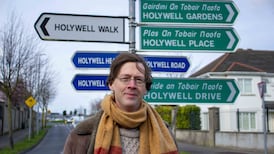Captain Ian Hume Dudgeon, who will be remembered as one of Ireland's consummate horsemen, died on September 22nd aged 77 after a lengthy battle against cancer. But that was not the only battle he fought in a long and distinguished career, both on the military and competition fields.
Born at the Royal Military Academy, Sandhurst, on June 21st, 1924, he was the second child and only son of Col Joe Dudgeon and his Scottish wife Sybil (nΘe Symington). He was educated at St Columba's College in Dublin before enlisting in the Royal Scots Greys, following his father into the cavalry regiment that was mounted only on grey horses.
The then Major Dudgeon retired from the regiment in 1938 and moved with his family to Merville House off Foster Avenue in Dublin (now part of UCD), where he started a riding school. Less than 18 months later, Major Dudgeon returned to active service at the outbreak of the second World War, moving to Scotland as commander of the Pack Transport regiment before seeing action in both the north African and Italian campaigns.
Meanwhile, his son was involved in the Normandy campaign of 1944 and was awarded the Military Cross. Less than a fortnight after the Normandy landings, Ian Dudgeon was seriously wounded when getting out of his tank to check the proximity of German troops. He was shelled and both legs were badly broken.
He spent six months in hospital in Basingstoke, where surgeons fought to save the most seriously injured leg. The resulting damage meant he had to adopt a new method of riding once he was allowed back on a horse.
While working with displaced persons in Germany after the war, he started riding again and became a confirmed follower of the teachings of Italian Federico Caprilli, who developed the forward seat now adopted worldwide for jumping. He adapted the technique to suit his own needs, using balance rather than strength to stay in the saddle. And it was a technique that paid dividends throughout a competitive career that spanned three decades and two disciplines.
Having finished as runner-up on Sea Lark at the inaugural Badminton three-day event, he represented Ireland at three Olympic Games. In 1952, he competed at Helsinki with the mare Hope and, four years later, rode in Stockholm on the Betty Parker-bred Copper Coin, which was later sold to America and won numerous medals as Grasshopper for Michael Page. His final Olympic outing was at the 1960 Games in Rome, where he took a catch ride on Eddie Boylan's Corrigneagh on the Irish team that finished sixth.
In the early 1950s Col Dudgeon was a founding member of the Irish Olympic Horse Trials Society. His son Ian was also involved in this forerunner of the Irish Horse Trials Society that has since gone on to become Eventing Ireland
Ian Dudgeon was also one of Ireland's most successful show jumpers. As well as victories at Harringay and Balmoral, he won the Irish Grand Prix at Dublin in both 1950 and 1952 with Go Lightly, netted a total of 11 championships at the RDS and was twice a winner of the Daily Telegraph Cup at Wembley.
He was both a great rival and great friend of Iris Kellett, sharing the Wylie Trophy for the national championship with her and Rusty in 1954. He won the trophy again with Go Lightly in 1959, when he shared the honours with Tommy Wade and Dundrum, before winning it for the third time in 1962.
In 1953, the Dudgeon family moved to Leopardstown, where Burton Hall became one of the world's most renowned riding schools. Among the graduates of Merville and, more particularly, Burton Hall were Penny McAuley (nΘe Moreton), Ada Matheson, Sheila Cassidy (nΘe Fleury), Pam Stokes, David Mitchell, Elspeth Gailey, Jean Mitchell, Patsy Bennett (nΘe Hildebrand), Malcolm Wallace and Nancy Caird, wife of the former Archbishop of Dublin, Donald Caird
When Col Dudgeon died in October 1965, Ian Dudgeon took over running the school until a compulsory purchase order on the property meant a move to Herbertstown near Fairyhouse in 1970. The school continued there, but on a much smaller scale until 1976, when Ian Dudgeon closed it down and moved to the Isle Of Man.
During his competitive career, Ian Dudgeon became a favourite with crowds all over Europe and he often switched his familiar bowler for a top hat at the bigger shows. He assumed that his popularity was partly centred around the topper, but crowds at the foreign fixtures adored him because, having seen his awkward gait while he walked the show jumping courses, they were convinced that they were watching a rider with two wooden legs!
Ian Dudgeon was a truly unique character. He was a free thinker and had an excitable temperament, but he was hugely kind and a man of great courage.
He is survived by his wife Valerie, children, Margaret, Emma and Andrew, and sister Kay Hunt.
Captain Ian Hume Dudgeon: born 1924; died, September 2001








